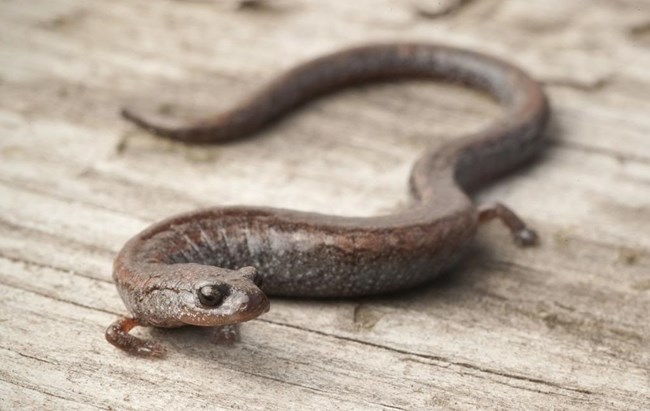Amphibians at Cabrillo National MonumentCabrillo National Monument, located on the Point Loma Peninsula in San Diego, California, is home to a variety of amphibian species. These amphibians play crucial roles in the local ecosystem, contributing to biodiversity and helping control insect populations. The moist coastal environment and the presence of various habitats, such as wetlands and shaded areas, make Cabrillo a suitable home for these fascinating creatures. Ecological ImportanceThe amphibians at Cabrillo National Monument are vital to the health of the ecosystem:

NPS photo Garden Slender Salamander (Batrachoseps major major)The Garden slender salamander, Batrachoseps major major, is a fascinating and unique amphibian known for its distinctive respiratory system and remarkable adaptability to various moist environments. Unlike many other amphibians, this salamander does not breathe through lungs. Instead, it relies on cutaneous respiration, meaning it absorbs oxygen directly through its skin and mouth tissues. This extraordinary adaptation requires the salamander to live in damp environments, where its skin can remain moist enough to facilitate gas exchange. Physical CharacteristicsAt first glance, the Garden slender salamander may be mistaken for a small, slimy worm due to its elongated, slender body and minute limbs. Typically, it measures about 2-3 inches in length. Its skin is smooth and moist, usually dark brown or black, which helps it blend into the leaf litter and soil where it resides. The salamander's short limbs are not well-suited for extensive movement on land, contributing to its worm-like appearance. Habitat and BehaviorThe Garden slender salamander is predominantly found in moist environments such as leaf litter, under logs, rocks, and other shaded, humid areas. These habitats provide the necessary moisture for its skin and create a safe haven from predators. The salamander is primarily nocturnal and is most active during wet weather, particularly in the winter months. During dry periods, it retreats to deeper, more humid layers of soil or other moist refuges to avoid desiccation. One of the remarkable traits of the Garden slender salamander is its ability to survive without the need for bodies of water for its lifecycle. Unlike many amphibians that require water for breeding and larval development, this species completes its entire lifecycle on land. However, it is capable of surviving in water if it accidentally falls into it, demonstrating its adaptability. Diet and Ecological RoleThe Garden slender salamander plays a crucial role in the ecosystem. Its diet consists primarily of small invertebrates, including insects, spiders, mites, and other tiny soil-dwelling organisms. By preying on these small creatures, the salamander helps control their populations, contributing to the balance of the soil ecosystem. Additionally, the salamander aids in the decomposition process by breaking down organic matter, which enriches the soil and promotes nutrient cycling. Reproduction and LifecycleReproduction in the Garden slender salamander occurs through direct development, meaning the eggs hatch into miniature versions of the adults without a larval stage. This adaptation eliminates the need for standing water during the reproductive phase. Females lay their eggs in moist, hidden locations such as under rocks or within decaying logs. The eggs are then left to develop, with the juveniles emerging fully formed and independent. Conservation and ImportanceWhile not currently listed as endangered, the Garden slender salamander faces threats from habitat destruction, pollution, and climate change. Urban development and deforestation can lead to the loss of the moist habitats crucial for its survival. Conservation efforts focus on preserving natural habitats and ensuring the maintenance of moist environments necessary for the species' respiration and overall well-being. For gardeners and naturalists, the presence of the Garden slender salamander in a garden or natural area is a positive indicator of a healthy, moist environment. These salamanders contribute to the biodiversity and ecological richness of their habitats, serving as both predator and prey within the food web. Their unique adaptations and behaviors make them a fascinating subject of study and observation, highlighting the incredible diversity and resilience of amphibians. What Are Amphibians?Amphibians are a class of cold-blooded vertebrates that are characterized by their ability to live both in water and on land. The term "amphibian" comes from the Greek word "amphibios," meaning "living a double life," which reflects their unique life cycle that typically involves both aquatic and terrestrial stages. Characteristics of Amphibians
Types of Amphibians
Ecological Importance
ConservationAmphibians are facing significant threats worldwide, including habitat destruction, pollution, climate change, disease (such as chytridiomycosis), and invasive species. Conservation efforts are essential to protect these species and maintain ecological balance. Initiatives include habitat restoration, pollution control, and breeding programs to support declining populations. Amphibians are a diverse and ecologically important group of vertebrates with unique adaptations that allow them to thrive in both aquatic and terrestrial environments. Their sensitivity to environmental changes makes them key indicators of ecosystem health and highlights the need for their conservation. |
Last updated: July 28, 2024
